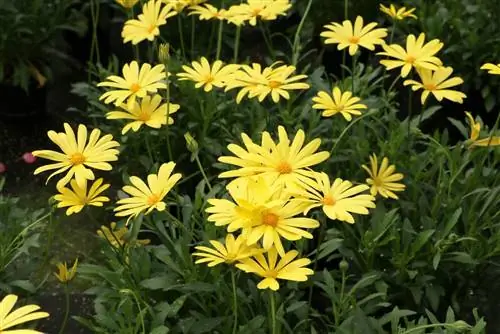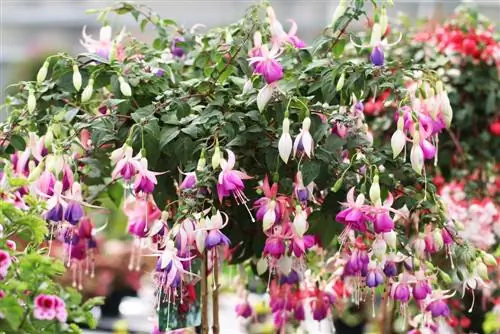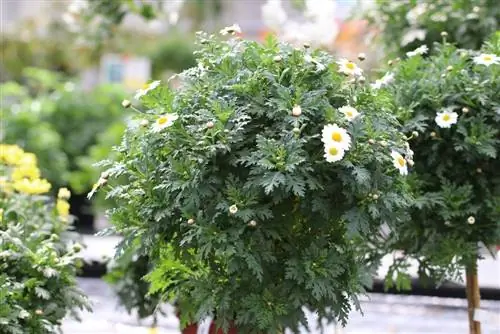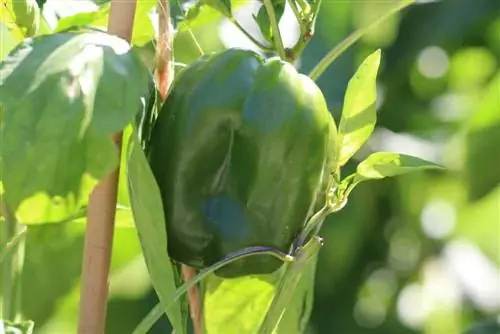- Author admin [email protected].
- Public 2023-12-17 03:39.
- Last modified 2025-01-24 12:45.
The Cape daisy or Cape daisy, Latin 'Osteospermum', is a striking flowering perennial. Because their daisy-like flowers offer the ultimate variety of colors. From May to October it enchants viewers and bathes beds and planters in cheerful colors. Thanks to its maximum height of 50 cm, it is a wonderfully natural beauty when planted in groups with other perennials. It deserves a permanent place in our garden.
A wide variety of flowers and shrubs bloom in our gardens. Whether a cottage garden, a natural garden or an exclusive garden, your own garden always reflects the personal taste and well-being of the hobby gardener. The flowers, perennials, shrubs and trees are selected according to these specifications. No matter how your own garden is designed, the Cape daisy or Cape basket should not be missing in any garden. Thanks to its expressiveness and variety of colors, it is an eye-catcher in every garden. Depending on the location, a specific color from the Cape basket's variety of colors can perfectly complete the look of a bed.
Profile
- Perennial or subshrub with dense and bushy growth, usually grown as an annual
- Growth height between 30 and 50 cm
- Leaves: elongated, entire or multi-toothed
- Flower: similar to daisies, flower heads in white, pink, violet, yellow or two-tone
- Flowering time: from May/June to October
- original growth, flowering and consistent
- loves sun to partial shade
- evergreen
- perennial
- not hardy
Seeds or young plants
'Osteospermum' should be purchased as a young plant. The young plants are hybrid breeds. They cannot be propagated by seeds. Although the seeds would germinate, they would develop into completely different-looking plants. If cultural hybrids are to be propagated, this can be done using cuttings. Cape basket hybrids are sold commercially as seeds. As a rule, these are the varieties of cape marigolds and not cape marigolds. Planting the seeds is easy. Sow in pots, cover with soil and keep moist. Keep warm at 18 to 20 °C. It takes about two weeks from the time the seeds emerge until each plant can be placed in its own pot. Since Cape baskets need warmth, they are only allowed to move into the garden bed at the end of May.
Location and soil
The 'Osteospermum' comes from Africa/Arabia. This explains their need for warmth and sun. The selected location should therefore be sunny and protected from cold winds. The Cape basket reacts to frequent shade or cold wind by decreasing its ability to bloom. The ideal garden soil is a nutrient-rich and well-drained mixture of soil, clay and sand. Because of its extremely lush flowering and variety of colors, the Cape daisy is also recommended as a balcony or terrace plant. It thrives particularly well on the sunny side, which is not easily tolerated by many balcony and terrace flowers. With its evergreen leaves, daisy-like flowers and the many colors to choose from, it is an attraction on every terrace and balcony.
Care
The Cape basket requires evenly moist soil. The plant cannot tolerate waterlogging. So only water when the top layer of soil is really dry. When planting in a container, any standing water in the saucer or planter should be poured out immediately. Cape baskets can tolerate some dryness over a short period of time. If waterlogged, the plant dies. The flowering of the cape baskets reaches its peak in midsummer. If the dead inflorescences are regularly removed, the formation of new flowers will be stimulated. Once the main flowering period is over, the plant is cut back so that many more lush flowers can be produced. This second flowering phase lasts until autumn. To prepare for winter, the evergreen plant is cut back to about a third before moving into its winter quarters. This means that it only has to care for a few leaves during the rest phase. This helps the plant get off to an optimal start after the winter break.
Fertilize
The Cape daisy / Cape basket blooms lushly and persistently. That's why it needs a boost of fertilizer at intervals of one to two weeks during the growing and flowering phase. If the plant becomes lazy to bloom despite regular fertilization, it is because it has received too much nitrogen. You should now switch to low-nitrogen fertilizer at the latest. From mid/end of August onwards, the resting phase for the Cape daisy slowly begins. From now on the 'Osteospermum' will no longer receive any fertilizer.
Propagation
Cape basket/Cape daisy hybrids are propagated by cuttings. To do this, about a hand's breadth of strong shoots are cut off in spring. The lower leaves of the shoot are removed and half of the shoot is placed in potting soil. Now the small cuttings need a warm location to root. Both softwood cuttings taken in spring and summer cuttings taken in summer and already half lignified quickly form roots. After rooting, they find their final place in a warm and moist location in a bed or pot. There are already seeds of the real Cape baskets/Cape daisies available in stores today. Care must be taken when purchasing these seeds. You can easily get 'Dimorphotheca sinuata', the cape marigold, instead of 'Osteospermum'. In contrast to the Cape basket, this is only an annual.
Wintering
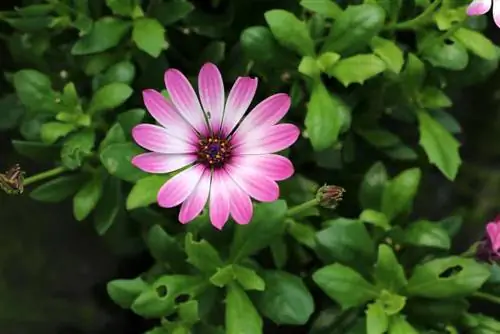
The genus 'Osteospermum', like geraniums or Mediterranean plants, has to overwinter in the so-called cold house. It should be noted that Cape baskets are evergreen. Although they take a break in autumn and winter, they continue to grow. That's why they need light and temperatures between 5 and 15 °C Celsius. During the rest period, Cape baskets/Cape daisies require little water. Just enough so that they don't dry out. No fertilizer application during the dormant phase. In frost-free weather, briefly airing out the winter quarters is good for the plants. The season for Cape baskets/Cape daisies begins again at the beginning of February. Now the plants are cut back to a hand's width. Then they are slowly placed as warm and as sunny as possible. This allows the plants to prepare for flowering. From mid-May, after the Ice Saints, they come back into the garden bed.
Tip:
Choose a slightly cloudy day for planting. The 'Osteospermum' can then get used to the light and sun outdoors better.
Diseases / Pests
The Cape basket is well resistant to diseases and pests. Avoiding stagnant air and too much irrigation water prevents diseases such as gray mold rot and fungal diseases. The most common pests include leaf miners and aphids. Aphids appear through heavily curled leaves and sticky plant parts. As a preventive measure, a decoction made from field horsetail helps people to help themselves because it strengthens the plant. In acute infestations, a soap solution or nettle manure helps. The infestation by leaf miners is shown by the pests' characteristic feeding passages on the leaves. Natural enemies such as parasitic wasps kill the pests. In the case of acute infestation, it is advisable to collect all affected leaves early on. Neem preparations are available commercially to combat it. When planting in containers, glue-coated yellow panels are also used to combat leaf miners.
Frequently asked questions
The once beautiful Cape baskets only bloom very little despite regular fertilizer applications. What are they missing?
The plant is most likely over-fertilized. Fertilize less or switch to low-nitrogen fertilizer.
Is the Cape basket poisonous?
No, the Cape basket 'Osteospermum' has no toxic potential.
Tips for speed readers
- Do not buy real cape baskets as seeds, but rather as young plants
- 'Osteospermum' requires nutrient-rich and permeable garden soil made of earth, clay and sand
- Keep soil moist at all times
- Waterlogging damages plants
- Propagation from spring or summer cuttings possible
- Overwintering in a cold house, bright location at 5 to 15 °C
- Fertilize regularly during the growing and flowering phase
- Illnesses are not to be expected with proper care
- Pest infestations of aphids or leaf miners are rare
What you should know about Cape baskets in brief
Location
- Cape baskets are heat-loving plants and therefore prefer full sun, warm locations.
- Loamy-sandy garden soil that is well drained is best suited for these plants.
- If they are cultivated in boxes or pots, they should be placed on the south side if possible.
Planting time and instructions
- Planting should only take place outdoors from May 20th, otherwise very young plants could freeze to ice during the last night frosts.
- For planting, some planting holes should be prepared with a plant shovel.
- The number depends on the number of young plants in stock.
- If you have grown young plants from seed in early spring, the planting holes must be correspondingly smaller.
- For all plants, however, planting distances of around 30 cm should be maintained, as some of them become very bushy.
- The long roots of very tender young plants are then shortened slightly using the index finger and thumb.
- Then they can be placed in the prepared planting hole. Now the remaining soil is filled in and pressed down.
- To secure it, the planting wood is inserted into the ground next to the plant at a distance of 1 to 2 cm and carefully moved in the direction of the plant.
- This means that enough soil reaches the roots and the plant can grow faster.
- Larger plants are placed with their pot balls in the prepared planting holes and pressed firmly.
- After planting, Cape baskets need to be watered frequently. Later this will only be necessary if there is a long drought.
Care
- Cape baskets in pots should receive conventional liquid fertilizer at weekly intervals about two weeks after planting. This is not necessary for plants outdoors.
- Withered flowers can be cleaned out regularly to encourage re-blooming. In addition, damp, withered cape baskets sometimes look a bit unsightly.
- The main bloom is expected on the hottest days of the year. The cape baskets can then be cut back by about a quarter to a third so that they can once again form a rich flower pile.
- Sometimes aphids like to nest on the leaves, stems and flowers of the cape. A spray with field horsetail broth can be used here as a preventive measure. This strengthens the plant.
- When spraying, all parts of the plant should be wetted. Shortly after planting, this can be repeated up to three times at weekly intervals.
- If aphids still appear, an insecticide from a specialist retailer can help.
- After the first frosts, the plant can be pulled up and composted.
- Of course, particularly strong specimens can be taken out of the ground and placed in pots to overwinter.
Popular varieties of cape basket
- ‘Gaiety’,
- ‘Giant Mixed’,
- ‘Glistening White’,
- ‘Ink Spot’,
- 'Salmon Queen',
- ‘Potpourri’ and
- ‘Starshine’
They come in strong white, bright yellow or typical pink and purple tones. These also include multi-colored and low-growing varieties.

